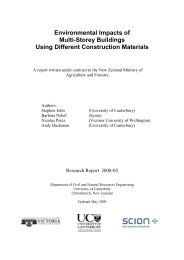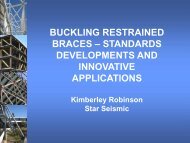Paper 27 Jake McLaren_Steel Innovations ppt_Feb 2013 Final.pdf
Paper 27 Jake McLaren_Steel Innovations ppt_Feb 2013 Final.pdf
Paper 27 Jake McLaren_Steel Innovations ppt_Feb 2013 Final.pdf
- No tags were found...
Create successful ePaper yourself
Turn your PDF publications into a flip-book with our unique Google optimized e-Paper software.
What is Life Cycle Assessment01.03.<strong>2013</strong>3
Life cycle thinking conceptAvoid solving a problem...... by creating a problem.4
Why the steelindustry is usingLife CycleAssessment
Why the steel industry is using LCA• LCA is a major tool used in material comparison and material decisionmaking in product design, considering the full value chain• Enhance brand value and reputation• Customers, product manufacturers and consumers want to know theimpact of what they purchase for their own studies• Recyclability of steel is a real strength, public perception is poor• Increasingly being used in regulations and standards• Can be used for CO 2 and energy calculations: popular metrics
Who is doing LCA work already in the metals sector?01.03.<strong>2013</strong>•7
Why the steel industry is using LCA• Understand company’s impact on the environment• Producer benchmarking – regionally or globally• Determine ‘hotspots’ and areas for environmental improvement• Environmental Product Declarations• The impact steel has in final product systems• Drive innovation8
worldsteel associationLCA programme• worldsteel provide LCA services for members for process improvement,material selection and product design.• worldsteel collects life cycle inventory data from steel plants all aroundthe world. Current dataset was released in <strong>Feb</strong>ruary 2010.• Data is available free of charge to everyone, from worldsteel membersand customers to researchers, LCA practitioners and policymakers.• Consistent approach for LCA of steel products exists and is agreedinternationally.9
Nat<strong>Steel</strong> Singapore LCA of Energy Reducing ProcessesIntroduction• Green Building Council of Australia (GBCA)• Set industry benchmarks for green buildings in Australia• Set Green Star <strong>Steel</strong> Credit criteria• Best Bar Reinforcements and Nat<strong>Steel</strong> Australia• Nat<strong>Steel</strong> Singapore Do the energy reducing processes used by Nat<strong>Steel</strong> Singapore meetthe GBCA Green Star <strong>Steel</strong> Credit requirement of 40 MJ/tone billet?11
GBCA Green Star <strong>Steel</strong> Credit CriteriaEnergy-Reducing Processes in <strong>Steel</strong> ProductionTo comply with this requirement, the reinforcing steel used in the projectmust be sourced from a steel maker using an energy-reducing process inmanufacturing. It must be shown that 60% of reinforcing products, measuredas a percentage of annual mass of reinforcing steel produced by the steelmaker, are manufactured with this technology.Energy reduction arising from energy-reducing processes must equate to atleast 40 MJ/tonne .To determine compliance with this benchmark, a lifecycle assessment must bemade in accordance with Protocol for Demonstrating Equivalency in EnergyReduction provided in Additional Guidance.Currently, reinforcing steel products sourced from a steel maker using aPolymer Injection Technology (PIT, as developed by the University of NSW)in manufacturing 60% of their reinforcing products is an acceptable methodof demonstrating compliance with this criterion.12
GBCA Green Star <strong>Steel</strong> Credit CriteriaEnergy-Reducing Processes in <strong>Steel</strong> ProductionTo comply with this requirement, the reinforcing steel used in the projectmust be sourced from a steel maker using an energy-reducing process inmanufacturing. It must be shown that 60% of reinforcing products, measuredas a percentage of annual mass of reinforcing steel produced by the steelmaker, are manufactured with this technology.Energy reduction arising from energy-reducing processes must equate to atleast 40 MJ/tonne .To determine compliance with this benchmark, a lifecycle assessment must bemade in accordance with Protocol for Demonstrating Equivalency in EnergyReduction provided in Additional Guidance.Currently, reinforcing steel products sourced from a steel maker using aPolymer Injection Technology (PIT, as developed by the University of NSW)in manufacturing 60% of their reinforcing products is an acceptable methodof demonstrating compliance with this criterion.13
GBCA Green Star <strong>Steel</strong> Credit Criteriahttp://www.gbca.org.au/uploads/33/1825/Green_Star_<strong>Steel</strong>_Credit_180612.<strong>pdf</strong>14
GBCA Green Star <strong>Steel</strong> Credit CriteriaProtocol for Demonstrating Equivalency in Energy Reduction(Equivalency Protocol)• The functional unit is 1 tonne of steel billet;• Boundary conditions are ‘cradle to gate’, meaning all production stagesfrom raw materials mined (cradle) to finished steel billet ready to beconverted to products (gate).15
GBCA Green Star <strong>Steel</strong> Credit CriteriaProtocol for Demonstrating Equivalency in Energy Reduction(Equivalency Protocol)• The functional unit is 1 tonne of steel billet;• Boundary conditions are ‘cradle to gate’, meaning all production stagesfrom raw materials mined (cradle) to finished steel billet ready to beconverted to products (gate).ScrapGBCA BoundaryElectric ArcFurnaceLadleFurnaceCasting(billet)16
Introduction Nat<strong>Steel</strong> SingaporeEnergy reducing processes:1. Scrap preheating2. Virtual lance burners (VLB)3. Hot charging – from steel mill directly into rolling millScrapElectric ArcFurnaceLadleFurnaceCasting(billet)Rolling millGBCA Scope17
Why a Life Cycle Approach?• Enables evaluation on equal basis• Electricity• Diesel• Graphite (carbon)• Oxygen• Accounts for efficiency of generation/production• Avoids burden shifting to other phases of the life cycle18
Results19
Results20
Results21
Results22
Results23
Results24
Results25
Case Study Conclusions• Each of the energy reducing processes investigated saves greater than 40MJ/tonne billet;• Nat<strong>Steel</strong> Holdings should be considered as a steel maker that uses severalenergy-reducing processes as defined by the current GBCA requirements;• Significant energy reducing processes are currently outside of the scope of theGBCA Green Star <strong>Steel</strong> Credit criteria;• As a steel billet is a “semi-finished steel form” it is recommended that theGBCA Green Star <strong>Steel</strong> Credit system boundary be extended; and• Best Bar Reinforcements have used the results of to demonstrate theircommitment to improving their environmental performance.26
Nat<strong>Steel</strong> LCA BenefitsExternal benefits• Exceed GBCA Green Star <strong>Steel</strong> Credit Criteria• Demonstrates commitment to continuous improvement• Access to “green” market and marketing materialsInternal Benefits• Independent recognition motivates staff• Identification of new opportunities to improve• Energy reduction, cost reduction, increased production<strong>27</strong>
EnvironmentalProductDeclarations(EPD’s)
Environmental labels according to ISO 14020Type I: Environmental labelsAccording to ISO 14024Type II: Self-declared environmentalclaimsAccording to ISO 14021Type III: Environmental ProductDeclaration (EPD)According to ISO 1402529
What is an Environmental Product Declaration?• A technical declaration of :• product technical performance,• life cycle assessment,• supplementary environmental information.• Based on independently verified manufacturerdata• Transparent and highly credible• Focus on B2B market• Can be for specific product or average for tradeassociation
Product Category Rules• EPD procedure andfundamentals areestablished in ProductCategory Rules (PCR)• Product group specificPCRs• Based on internationalstandardsExample available buildingmaterial PCRs• Construction metal• Roof stone• Roof tile• Fiber cement• Floor covering• Derived timber product• Wood cement• Lime sand stone• Light concrete• Light supplement• Metal-Installation tubes• Mineral Insulation materials• Mineral mortar• In situ concrete• Foam plastics• Laminated material•Tiles01.03.<strong>2013</strong>31
Australasian EPD schemePrinciples• Scheme currently in development by LCANZ and ALCAS• Core purpose is trans-Tasman and international alignment with respectto PCR and EPD development• Process for obtaining an EPD in Australia and New Zealand should beidentical from a customer perspective• One set of PCRs covering Australia and New Zealand, with any countryspecific issues set out in specific PCRs• PCRs and EPD developed through the Australasian EPD Scheme arerecognised and accepted by an established international EPD provider33
Australasian EPD schemeCurrent status• Established EPD schemes in Germany and Sweden are interested incollaboration• LCANZ and ALCAS are currently developing the business case• Green Building Councils in New Zealand and Australia are interestedand kept in the loop by LCANZ and ALCAS respectively• Product average, sector average or generic EPD, would be countryspecific (Australia or New Zealand) but would not comprise an averageacross Australasia.
Conclusions
Concluding comments• LCA is a tool to support the long term sustainability of the steel sector.• Life cycle thinking considers the whole value chain and the supportsinnovation at different levels.• LCA results can support market claims and inform policy and standardsdevelopment.• Environmental Product Declarations are increasingly used tocommunicate LCA results transparently.• An Australasian EPD scheme is currently being developed by LCANZand ALCAS.
Contact detailsPE Australasia<strong>Jake</strong> <strong>McLaren</strong>, Principal Consultantj.mclaren@pe-international.comtel. +64 4 889 2581mob. +64 21 863 806www.pe-international.com
















